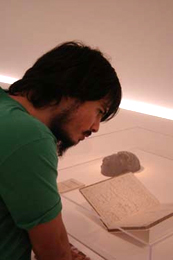
A visit to the Hamburger Bahnhof was incorporated into the course on Human-Animal Relations in Historical Perspective, as part of an ongoing discussion of the capacity to feel pain and to suffer as criteria for the ethical consideration of animals. The exhibition, simply entitled Schmerz runs from April to August, 2007.
On display was an unsettling mix of art, artefacts relating to the history of science and medicine, and personal accounts relating to the subjectivity of pain. The eclecticism was made coherent by the consistency with which questions were asked of the viewer, thinking through the various pieces on display: What is the meaning of pain? How can it be measured? How does it relate to pleasure? How do we experience and express pain, both directly (physical and mental pain), and indirectly (through compassion, pity, etc.)?
Foremost in our minds was Jeremy Bentham, who notoriously stated that ethical consideration depended not on one’s capacity to reason or to speak, but on the capacity to suffer (An Introduction to the Principles of Morals and Legislation, 1789). Philosophers have tended to see this as the widening of philosophy’s scope to include non-human animals, though the implications of this Benthamite footnote are controversial. Alongside Bentham, the philosophical model of Richard Ryder – Painism (2001) – was a major topic of conversation. Pain, according to Ryder, is the chief ethical concern. The reduction of the suffering of the individual in most pain, be s/he human or animal, serves as Ryder’s raison d’être. Several pieces in the exhibition were ideal stimuli for discussion.
Günter Biedermann’s Narkose (1964), an educational film for medical students on the virtues of anaesthesia, interweaved footage of a human patient and a dog on the operating table, with all the painful, un-anaesthetised actions being carried out on the dog. This is a clear example of the historicity of sensibility. While contemporary viewers flinch at the pinching of the dogs paws, the film was presumably designed this way so as not to offend.
In the next room, Berlinde de Bruyckere’s Speechless Grey Horse (2004) – a mutilated and decapitated horse carcass, with the hide roughly stitched back on – raised questions of suffering and the significance of being unable verbally to protest. The giant carcass is shocking to the eye: the obvious power of the animal rendered inert and butchered, sprawled on the cold gallery floor. It is not art for all tastes, but that is surely the point.
Finally, Francis Bacon’s Crucifixion (1965) triptych makes a powerful point by confusing the grotesque scenes of the abattoir with the death of Christ, reducing these disparate worlds to the common theme of suffering. The uncertainness of the form here – is it human? is it animal? – though modern, immediately re-invokes Bentham’s tracing of the ‘insuperable line’ between humans and animals.
A major question remains: how to make sense of the pleasure taken from indulging in all this pain.
Article by Rob Boddice (Faculty)
